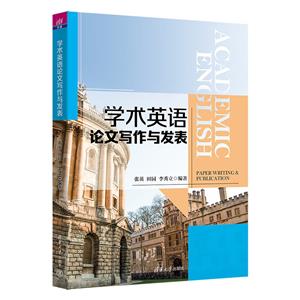-
>
分類速記英語單詞4000個(口袋本)
-
>
新東方 背單詞,記住這200個詞根詞綴就夠了
-
>
(精)古代漢語三百題
-
>
增廣賢文
-
>
優(yōu)秀的綿羊
-
>
北京大學(xué)
-
>
校園英語即學(xué)即用(附光盤)
學(xué)術(shù)英語論文寫作與發(fā)表 版權(quán)信息
- ISBN:9787302615804
- 條形碼:9787302615804 ; 978-7-302-61580-4
- 裝幀:一般膠版紙
- 冊數(shù):暫無
- 重量:暫無
- 所屬分類:>
學(xué)術(shù)英語論文寫作與發(fā)表 本書特色
本教材旨在提升研究生的學(xué)術(shù)寫作能力,通過教授文本寫作理論與練習(xí)培養(yǎng)學(xué)生的寫作技能,細(xì)致呈現(xiàn)學(xué)術(shù)英語 論文寫作的體裁特征、語言特點和語篇建構(gòu)技巧,體現(xiàn)學(xué)術(shù)共性與學(xué)科差異,支撐學(xué)校主流學(xué)科人才培養(yǎng),切實貼近研究生的實際英語學(xué)術(shù)寫作需求。
學(xué)術(shù)英語論文寫作與發(fā)表 內(nèi)容簡介
本教材共12個單元,系統(tǒng)涵蓋了學(xué)術(shù)英語論文的主要組成部分,即學(xué)術(shù)英語論文各個部分的功能、基本邏輯發(fā)展、語言修辭特征和語言使用模板。此外,本教材還介紹了國際會議往來書信的寫作與海報的制作以及論文發(fā)表的相關(guān)問題。同時,本教材還聚焦學(xué)生寫作中常見的錯誤以及錯誤產(chǎn)生的原因。各單元的具體內(nèi)容為:學(xué)術(shù)英語論文寫作中的引言;文獻(xiàn)綜述;研究方法;研究結(jié)果;結(jié)果討論;研究結(jié)論;摘要與標(biāo)題;參考文獻(xiàn);學(xué)生寫作常見錯誤分析;中式英語與標(biāo)準(zhǔn)英語對比;國際會議海報及數(shù)據(jù)展示;論文發(fā)表。教材配備PPT課件和練習(xí)答案,讀者可登錄ftp://ftp.tup.tsinghua.edu.cn下載使用。 本教材適用于非英語專業(yè)的碩士和博士研究生、本科高年級學(xué)生以及科技和人文學(xué)科的學(xué)者和教師。
學(xué)術(shù)英語論文寫作與發(fā)表 目錄
Unit 1 Introduction. 1
1.1 Overview2
1.1.1 Purpose of the Introduction Section2
1.1.2 Information Elements of the Introduction Section2
1.1.3 Main Focus of Writing the Introduction Section.2
1.2 Sample Analysis4
1.3 Linguistic Features of the Introduction Section.8
1.3.1 Lexical Features8
1.3.2 Syntactical Features10
1.4 Useful Expressions for the Introduction Section13
1.5 Reflections and Practice15
Unit 2 Literature Review 27
2.1 Overview28
2.1.1 Purposes of the Literature Review Section28
2.1.2 Information Elements of the Literature Review Section28
2.1.3 Principles of Writing the Literature Review Section30
2.1.4 Citation Methods in the Literature Review30
2.1.5 Organizational Patterns of the Literature Review Section.32
2.1.6 Common Problems of Writing the Literature Review Section34
2.2 Sample Analysis.34
2.3 Linguistic Features of the Literature Review Section37
2.3.1 Lexical Features37
2.3.2 Syntactical Features39
2.4 Plagiarism and Paraphrase41
2.4.1 Plagiarism41
2.4.2 Paraphrase43
2.5 Useful Expressions for the Literature Review Section43
2.6 Reflections and Practice45
Unit 3 Methods. 55
3.1 Overview 56
3.1.1 Purpose of the Methods Section56
3.1.2 Information Elements of the Methods Section56
3.1.3 Principles of Writing the Methods Section58
3.2 Sample Analysis58
3.3 Linguistic Features of the Methods Section62
3.3.1 Lexical Features.62
3.3.2 Syntactical Features.63
3.4 Useful Expressions for the Methods Section.68
3.5 Reflections and Practice.70
Unit 4 Results. 77
4.1 Overview78
4.1.1 Purpose of the Results Section78
4.1.2 Information Elements of the Results Section78
4.1.3 Sequential Structure of the Results Section.79
4.1.4 Principles of Results Presentation80
4.1.5 Common Mistakes in Writing a Results Section81
4.1.6 Criteria for Judging a Results Section81
4.2 Sample Analysis82
4.3 Linguistic Features of the Results Section94
4.3.1 Lexical Features.94
4.3.2 Syntactical Features.95
4.4 Useful Expressions for the Results Section97
4.5 Reflections and Practice98
Unit 5 Discussion 107
5.1 Overview.108
5.1.1 Purpose of the Discussion Section.108
5.1.2 Information Elements of the Discussion Section108
5.1.3 Principles of Writing the Discussion Section110
5.1.4 Organizational Pattern of the Discussion Section 111
5.2 Sample Analysis111
5.3 Linguistic Features of the Discussion Section.118
5.3.1 Lexical Features118
5.3.2 Syntactical Features121
5.4 Useful Expressions for the Discussion Section122
5.5 Reflections and Practice124
Unit 6 Conclusion. 133
6.1 Overview134
6.1.1 Purpose of the Conclusion Section134
6.1.2 Information Elements of the Conclusion Section.134
6.1.3 Principles of Writing the Conclusion Section.136
6.1.4 Common Problems of Writing a Conclusion Section136
6.2 Sample Analysis137
6.3 Linguistic Features of the Conclusion Section141
6.3.1 Lexical Features141
6.3.2 Syntactical Features144
6.4 Useful Expressions for the Conclusion Section.147
6.5 Reflections and Practice.150
Unit 7 Title and Abstract 157
7.1 Overview158
7.1.1 Purposes of the Title158
7.1.2 Principles of Writing a Title158
7.1.3 Types of Titles159
7.1.4 Capitalization of the Title.160
7.1.5 Purposes of the Abstract.161
7.1.6 Information Elements of the Abstract161
7.1.7 Types of Abstracts.162
7.1.8 Common Problems of Writing the Abstract.163
7.2 Sample Analysis164
7.2.1 Title Analysis.164
7.2.2 Different Types of Abstracts165
7.2.3 Textual Analysis of the Abstract168
7.3 Linguistic Features of the Title and the Abstract171
7.3.1 Lexical Features171
7.3.2 Syntactical Features.174
7.4 Useful Expressions for the Abstract177
7.5 Reflections and Practice.179
Unit 8 Referencing 187
8.1 Overview 188
8.1.1 Purpose of Referencing 188
8.1.2 Information Elements of Referencing 188
8.1.3 Referencing Styles190
8.2 Sample Analysis202
8.3 Reflections and Practice205
Unit 9 Common Mistakes in Students’ Writings 211
9.1 Common Mistakes 212
9.1.1 Lexical Level.212
9.1.2 Syntactical Level214
9.1.3 Textual Level.217
9.1.4 Academic Conventions 224
9.2 Reflections and Practice226
Unit 10 Chinglish vs. English. 231
10.1 Overview232
10.1.1 Interlingual Errors of Chinglish.232
10.1.2 Positive and Negative Transfer Between Two Languages232
10.2 Sample Analysis of Representational Chinglish Structures.233
10.2.1 Interferences of Chinese Culture233
10.2.2 Interferences of Chinese Thinking Pattern234
10.2.3 Inappropriate Expressions238
10.2.4 Confusion Between Coordination and Subordination.239
10.3 Some Salient Differences Between English and Chinese.240
10.3.1 Reversed Word Order.241
10.3.2 Postpositive Attributive in English241
10.3.3 Static English and Dynamic Chinese242
10.3.4 Multifunction of English Attributive Clauses242
10.3.5 Compact English and Relatively Loose Chinese243
10.3.6 Chinese Four-Character Sentences and English Words and Phrases244
10.3.7 English Passive Sentences and Chinese Sentences with No Subjects244
10.3.8 Inanimate Subjects in English and Chinese Sentences245
10.4 Reflections and Practice246
Unit 11 Posters for International Conferences and Data Presentation 251
11.1 Overview.252
11.2 Pre-Conference Correspondence 252
11.3 Making a Research Poster.255
11.3.1 What Is a Research Poster?.255
11.3.2 Instructions on Making a Poster for an International Conference256
11.3.3 Design Suggestions for Scientific Posters258
11.4 Information Elements of Posters.259
11.5 Poster Samples259
11.6 Linguistic Features of Posters.262
11.7 Data Presentation265
11.8 Reflections and Practice268
Unit 12 Manuscript Publication 271
12.1 Overview272
12.1.1 Aims and Scope of the Target Journal272
12.1.2 Guide for Authors273
12.1.3 Cover Letter 275
12.2 Response to Editors and Reviewers .276
12.2.1 Peer-Review Process276
12.2.2 Three Golden Rules of Responding to Reviewers’ Comments277
12.3 Reflections and Practice280
References. 285
學(xué)術(shù)英語論文寫作與發(fā)表 作者簡介
張英,清華大學(xué)語言教學(xué)中心副教授,北京市高等教育學(xué)會研究生英語教學(xué)研究分會副理事長、常務(wù)理事,南開大學(xué)英美語言文學(xué)學(xué)士、新加坡南洋理工大學(xué)英語教育與教學(xué)研究生、清華大學(xué)語言學(xué)與應(yīng)用語言學(xué)碩士。曾獲得國家留學(xué)基金委和清華大學(xué)資助出國留學(xué)訪學(xué)新加坡南洋理工大學(xué)、美國加州大學(xué)圣芭芭拉分校和英國牛津大學(xué)。長期從事清華大學(xué)博士研究生、碩士研究生和本科生公共英語教學(xué),近年來承擔(dān)博士生英語論文寫作發(fā)表、碩士生英語論文閱讀寫作、碩士生綜合學(xué)術(shù)英語、碩士生英語語言文化交流等課程。
- >
苦雨齋序跋文-周作人自編集
- >
月亮與六便士
- >
羅曼·羅蘭讀書隨筆-精裝
- >
人文閱讀與收藏·良友文學(xué)叢書:一天的工作
- >
我從未如此眷戀人間
- >
莉莉和章魚
- >
【精裝繪本】畫給孩子的中國神話
- >
推拿
-
新核心高職英語C版綜合教程.2
¥26.9¥39.8
















